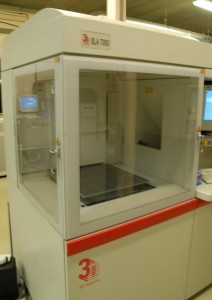3D Systems buys Bits from Bytes
3D Systems was built on Stereolithography technology. The technology was invented by 3D Systems CTO Chuck Hull in 1986. Right now 3D Systems still is the leading player on the Stereolithography field. But, 3D Systems did not just keep to Sterolithography but rather expanded into SLS (Selective Laser Sintering) machines also. Last year it was 3D Systems that bought the assets of the defunct Desktop Factory. I”m still unsure what 3D Systems wants to do with this technology but former Desktop Factory CEO Cathy Lewis is turning out to be quite an asset in making the company more accessible and well known.
3D Systems has spent the last year acquiring 3D printing service bureaus the world over from specialised ones that do investment casting such as Mqast to regular service bureaus. It is cobbling them together in order to develop a network with one web based 3D printing service called ProParts. With lower material costs than other service bureaus and nice deals on the machines I”m guessing that 3D Systems will want to squeeze a lot of 3D printing service beaureaus in the future.
3D Systems” entry level 3D printer offering has so far consisted of the untested V Flash machine but this was not enough for the company. 3D Systems today acquired Bits From Bytes. Bits From Bytes is a UK Based company making 3D printers and 3D printing kits largely for the educational market. The company is doing well in the UK and elsewhere with the BFB 3000 is more expensive than the more well-known Makerbot device coming in at around $3000 for the assembled device.  But people who own them are impressed by the larger build volume and say the devices are relatively robust and reliable. Having said that a friend of mine owns one and it only works properly while the dryer is on and the printer is printing close to the dryer. The entry level systems are currently all trying hard but not yet reaching the reliability level that consumers are used to from consumer electronics.
The 3D Systems acquisition is a huge boost to the bottom of the market and a real validation for the approach taken by Makerbot to putting a device on desks. I would assume that this will get some Sand Hill Road types to call Bre and his buddies over at Makerbot. The Makerbot ecosystem is the main competitor for the Bits and Bytes machines. Makerbot has more traction with the media and a much more vibrant community but the BFB machines can be pre assembled so this is a clear advantage.
3D Systems competitor Stratasys also has a 3D printing service RedEye and it has an entry level 3D printer offering together with HP.  But its $13,000 HP branded printer now looks expensive next to 3D Systems BFB 3D printer. The HP printer should be much more reliable and was aimed for an office market segment rather than a home one. Stratasys” FDM technology is making inroads in the direct digital manufacturing field and it is there that many of the battles for market share in 3D printing are being fought. EOS, the German Selective Laser Sintering vendor has stuck to its guns making only machines as have many of the other smaller 3D printer vendors.
3D Systems currently retails machines in various technologies and in various market segments. With an offering that starts at $3000 and goes up to $100,000,000 in machines 3D Systems is betting heavily on the emergence of both the “desktop manufacturing” market for the home as well as the  “direct digital manufacturing” market for large companies. This coupled with the ProParts service bureau means that 3D Systems now covers almost the entire 3D printing market. But, will the company be able to keep its focus? Will it be able to execute well across the market?
Will 3D Systems be able to integrate all these assets and benefit from them optimally? The jury is still out on that one, but it seems that 3D Systems CEO Abe Reichental is doubling down on the emergence of a mass market for 3D printing.
Recommended Articles
No related posts.



